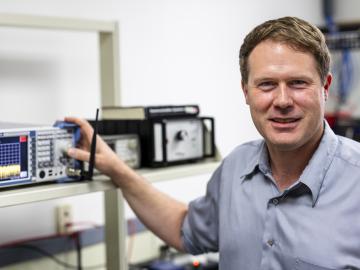
Filter News
Area of Research
News Type
News Topics
- (-) Composites (8)
- (-) Frontier (20)
- (-) Materials (18)
- (-) National Security (29)
- (-) Physics (8)
- (-) Security (6)
- 3-D Printing/Advanced Manufacturing (24)
- Advanced Reactors (3)
- Artificial Intelligence (33)
- Big Data (23)
- Bioenergy (11)
- Biology (17)
- Biomedical (11)
- Biotechnology (6)
- Buildings (21)
- Chemical Sciences (20)
- Clean Water (4)
- Computer Science (33)
- Critical Materials (5)
- Education (2)
- Emergency (3)
- Energy Storage (10)
- Environment (28)
- Exascale Computing (24)
- Fossil Energy (4)
- Fusion (8)
- Grid (12)
- High-Performance Computing (37)
- Hydropower (1)
- Isotopes (12)
- ITER (2)
- Machine Learning (20)
- Materials Science (21)
- Mathematics (6)
- Microelectronics (1)
- Microscopy (3)
- Nanotechnology (1)
- Neutron Science (17)
- Nuclear Energy (12)
- Partnerships (24)
- Polymers (2)
- Quantum Computing (16)
- Quantum Science (20)
- Simulation (20)
- Space Exploration (3)
- Statistics (2)
- Summit (13)
- Transportation (7)
Media Contacts

ORNL researcher Corey Cooke investigates challenges in radar, digital signal processing and communications systems while serving as a joint faculty member at Tennessee Tech, teaching online courses and advising graduate students to create a pipeline for new researchers to the lab and support the growth of current staff.

Researchers led by the University of Melbourne, Australia, have been nominated for the Association for Computing Machinery’s 2024 Gordon Bell Prize in supercomputing for conducting a quantum molecular dynamics simulation 1,000 times greater in size and speed than any previous simulation of its kind.

ORNL and NASA co-hosted the fourth iteration of this invitation-only event, which brings together geospatial, computational, data and engineering experts around a theme. This year’s gathering focused on how artificial intelligence foundation models can enable geospatial digital twins.

Researchers have developed and 3D printed the lightest crack-free alloy capable of operating without melting at temperatures above 2,400 degrees Fahrenheit, which could enable additively manufactured turbine blades to better handle extreme temperatures, reducing the carbon footprint of gas turbine engines such as those used in airplanes.

To bridge the gap between experimental facilities and supercomputers, experts from SLAC National Accelerator Laboratory are teaming up with other DOE national laboratories to build a new data streaming pipeline. The pipeline will allow researchers to send their data to the nation’s leading computing centers for analysis in real time even as their experiments are taking place.

ORNL researchers were honored with a prestigious ACE Award for Composites Excellence by the American Composites Manufacturers Association. The team won the “innovation in green composites design” prize for creating a fully recyclable, lightweight wind turbine blade tip that incorporates low-cost carbon fiber and conductive coating for enhanced protection against lightning strikes.

ORNL's Spallation Neutron Source, the nation’s leading source of pulsed neutron beams for research, was recently restarted after nine months of upgrade work.

The Oak Ridge Leadership Computing Facility welcomed users to an interactive meeting at the Department of Energy’s Oak Ridge National Laboratory from Sept. 10–11 for an opportunity to share achievements from the OLCF’s user programs and highlight requirements for the future.

Distinguished materials scientist Takeshi Egami has spent his career revealing the complex atomic structure of metallic glass and other liquids — sometimes sharing theories with initially resistant minds in the scientific community.
Summer interns at the Department of Energy’s Oak Ridge National Laboratory recently dove into various smart devices to better understand cybersecurity vulnerabilities posed by technology meant to simplify a user’s life.


